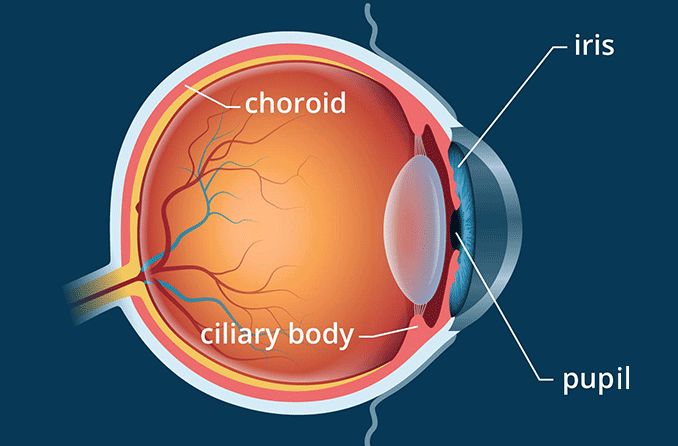Ciliary body of the eye

The ciliary body is a circular structure in the eye that is connected to the iris and is located directly behind it. It produces the aqueous fluid inside the eye. The ciliary body also includes a muscle that enables the lens of the eye to focus on near objects. This ring of tissue is one of three components that make up the uvea of the eye — the pigmented middle layer of the eye. The other two parts are the iris (the colored part of the eye), and the choroid (the part of the eye that nourishes the retina). These two segments are connected together by the ciliary body.
What is the ciliary body?
Structurally, the ciliary body is a ring of tissue that surrounds the iris and connects it to the choroid. The ciliary body can’t be seen when you look at the eye, because it’s located behind the iris and sclera, which is the white part of the eye.
Structures contained within the ciliary body include:
The ciliary muscle, which influences the shape of the lens inside the eye. Contraction of the ciliary muscle makes the lens become more convex, enabling the eye to focus on near objects. The ciliary muscle is connected to the lens by a series of very thin, radially-arranged fibers called the ciliary zonules (also called the zonular fibers or zonules of Zinn), which hold the lens in place within the eye.
The ciliary processes, which are about 70 ridges in the ciliary body that contain cells involved in the production of the aqueous humor in the eye that controls eye pressure.
SEE MORE: Eye anatomy
Ciliary body functions
There are three main functions of the ciliary body: accommodation, holding the lens in place and producing aqueous fluid.
Accommodation refers to the eye’s ability to automatically increase its focusing power to enable the eye to see near objects clearly. This action depends on the ciliary muscle.
The ciliary body holds the lens of the eye in place behind the pupil using tiny fibers called ciliary zonules or zonules of Zinn.
Aqueous fluid production occurs in the ciliary body. Aqueous fluid (or aqueous humor) is the clear fluid in the eye that provides nourishment and helps the eye maintain its shape as well as healthy pressure levels.
Each of these functions is essential for the health of the eye — in fact, conditions such as ocular hypertension and glaucoma can occur if too much aqueous fluid is produced by the ciliary body.
Ciliary body and glaucoma
The aqueous humor — which is constantly produced by the ciliary body — drains through a channel called the trabecular meshwork, located at the angle where the iris and cornea meet.
There must be a balance between how much aqueous humor is being produced and how much is drained in order to maintain a healthy amount of pressure in the eye. This is known as the intraocular pressure (IOP).
Ocular hypertension is the term used to describe higher-than-normal IOP. This elevated pressure can in turn lead to glaucoma — the term used to describe a group of related eye conditions that cause damage to the optic nerve and can lead to blindness if left untreated.
READ NEXT: Staphyloma
How does glaucoma medication affect the ciliary body?
Typically, the initial treatment used for glaucoma is medicated eye drops, which are designed to help regulate eye pressure by reducing the production of aqueous fluid by the ciliary body and/or increasing its drainage from the eye.
Some of the most common forms of glaucoma medication that affect the ciliary body include:
Carbonic anhydrase inhibitors such as Azopt (brinzolamide) and Trusopt (dorzolamide).
Beta blockers such as Betoptic (betaxolol) and Timoptic (timolol).
Alpha-adrenergic agonists such as Alphagan P (brimonidine) and Iopidine (apraclonidine).
SEE RELATED: Cycloplegic and Mydriatic Eye Drops
Ciliary body and presbyopia
Presbyopia is the normal, age-related loss of ability of the eyes to focus on near objects. It usually occurs sometime after age 40.
Presbyopia occurs because the lens of the eye thickens over time and loses its natural flexibility. The ciliary body retains its ability to function, but the lens fails to change shape to enable near objects to come into focus.
Fortunately, presbyopia is treatable with eyeglasses, contact lenses or vision surgery. For some, over-the-counter reading glasses are a simple solution for presbyopia.
When to see an eye doctor
Problems related to the ciliary body can be associated with serious eye conditions such as glaucoma. Because there are no early warning signs of the disease, comprehensive eye exams by an optometrist or ophthalmologist are the only way to prevent vision loss from glaucoma. If you have noticed signs of presbyopia, contact an eye doctor for an eye exam and to discuss the best treatment option moving forward.
The ciliary body is not the only part of the vision system that must be cared for. Stay up to date on annual eye exams to ensure optimal eye and vision health, and don’t hesitate to contact your eye doctor for any additional vision concerns you may have.
Page published on Tuesday, March 2, 2021




